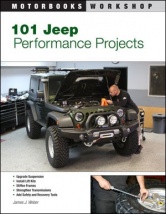 101 Jeep Performance Projects. Click image to enlarge |
By Russell Purcell
For the better part of seven decades, Jeep vehicles have been establishing a go-anywhere image across the globe. The Jeep name is considered one of the automotive world’s most iconic brands due to the fact that the company’s vehicles have been providing adventurous individuals with go-anywhere transportation, a valiant workhorse, and hours of weekend family fun.
Another function that makes Jeep models so popular is the fact they are relatively easy to customize and modify. Author James J. Weber’s latest book, 101 Jeep Performance Projects, is unique in that the noted Jeep expert provides the reader with step-by-step instructions to complete a variety of projects that will help them extract the most performance, fun and reliability from their Jeep vehicle.
As part of the Motorbooks Workshop series of titles you know that the information contained between its covers is both accurate and easy to follow.
Weber’s presentation will no doubt make outfitting your Jeep a little less stressful as he uses visual aids in the form of sequentially numbered photographs (complete with concise captions) to lead you through each project from beginning to end.
If you possess basic mechanical skills, you will feel comfortable performing general maintenance tasks such as oil changes, lubrication and bulb replacements after reading the first section of this book.
On the other hand, should you be skilled with a wrench, Weber’s book features a wealth of projects designed to help increase the performance of your Jeep’s engine. Some of the most popular modifications include the installation of a Ram-Air intake, performance exhaust system, and of course, a supercharger.
Serious trail runners will appreciate step-by-step instructions for the installation of a snorkel system, an essential device to help keep your Jeep alive during those deep water crossings, as well as a lesson on how to reprogram your vehicle’s ECU to correspond to larger wheel and tire fitments.
The author elected to include a quick reference guide at the top of each project page to help you decide if you have the time, tools, knowledge and resources needed to get that particular job done. This guide also lets you know how the project will improve your vehicle’s performance, as well as if there are any “complimentary” projects that will further enhance the benefits offered by performing the work.
Drivetrain projects include the likes of driveshaft and axle upgrades, the installation of skid-plates and differential covers, and performing a hydraulic steering system conversion. There are no less than 15 projects in the section dedicated to suspension work, which means this book should help take some of the mystery out of prepping your Jeep for serious off-road duty.
Venturing off the beaten track can be dangerous so occupant safety should always be a priority. As a result, Weber has included projects that focus on building a proper roll cage, installing passenger restraints, the placement of grab handles, and installing dedicated racing seats. Exterior modification work includes the installation (and finishing) of items such as bumpers, rock guards fender flares and mouldings.
If you plan to install accessories such as winches, auxiliary lighting and air compressors, you may need to upgrade your electrical system. The author devotes a section of the book to fuses, wiring, and lighting installs, followed by a series of projects related to audio, video and communications equipment. You won’t emerge an electrician after reading this material, but you are far less likely to shock yourself, fry your gear, or trigger an electrical fire.
I suspect that many readers will immediately flip to the section of the book dedicated to wheels and tires, as the selection of proper rolling stock for a Jeep vehicle is one of the most important considerations one has to make when outfitting an off-road vehicle. The author discusses the advantages and disadvantages of some of the most popular brands and models currently available. Maintenance issues in this department include such tasks as how to repair a flat tire, replace wheel studs, install wheel spacers, and the proper usage of self-deflating valve stems.
The final five projects involve prepping the Jeep with the necessary gear the author feels is essential to have on hand to get yourself out of trouble should things go awry on the trail. Winches and fire extinguishers are obvious topics in this department, but Weber gives us a quick look at a set of products and tools that should be part of any trail recovery kit.
Whether you are a long time Jeep aficionado or even a new owner, this book should become part of your required reading list if you plan to venture off-road in your vehicle on a regular basis. Trust me, this book could save you a great deal of frustration. Most of the projects can be accomplished in an evening or by tinkering in the garage over a weekend, saving you big labour charges and hopefully, rewarding you with a better performing and more reliable rig in the process.
While the projects described in this book are specifically designed for Jeep vehicles (and I should point out that this means CJ, YJ, TJ and Wrangler models), with a little additional effort, many of the projects could be adapted to work on other makes and models.
101 Jeep Performance Projects, by James J. Weber
Motorbooks Publishing
ISBN: 978-0-7603-3164-4
MSRP: CAN$43.99







 Follow Autos on Twitter
Follow Autos on Twitter



